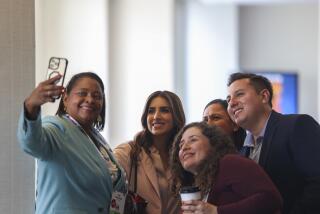Gay Journalists Hold First Conference : Media: Delegates assess progress being made against newsroom hostility and the battles that remain.
- Share via
SAN FRANCISCO — Two years ago, Roy Aarons invited five Bay Area colleagues to his home for a discussion of their common concerns as gay journalists. Aarons was then the executive editor of the Oakland Tribune, the only openly gay, top-level editor at any mainstream daily newspaper in the country. This weekend, with a proud smile, Aarons moved his living room discussion to far larger quarters, with a far broader agenda. He presided over the first conference of the National Lesbian and Gay Journalists Assn.
Founded last year, the association has almost 600 members in nine cities, including Los Angeles, and Aarons is its president. About 300 delegates attended the two-day conference.
High-ranking editors from the Los Angeles Times, Washington Post and Oakland Tribune appeared on a panel. Arthur O. Sulzberger Jr., publisher of the New York Times, delivered a videotaped message in which he said newspapers must cover the gay community as they must cover other minority communities if they are to fulfill their journalistic role.
“I’m convinced that if newspapers are to survive they can no longer be exclusionary bastions of a single view of the world,” he said.
Sulzberger’s message was especially heartening to gay and lesbian journalists, not only because of the paper’s preeminent position in the American media but also because the paper was long regarded as being hostile to gays.
Sulzberger alluded to this reputation when he said: “Not very many years ago, gays and lesbians at the (New York) Times lived in fear.
“They don’t today,” he said, and although the New York Times has no openly gay senior editors or top managers, “we will,” he added.
The association honored the New York Times for its “increased overall coverage of gay and lesbian issues.”
Delegates explored the near “invisibility” of lesbians in the nation’s news media; the exclusion of gays and lesbians from most routine coverage; the progress that gays have made in the battle against intolerance--and the battles that remain; coverage of AIDS and other issues of special interest to gays, and the necessity of working with journalists who represent other minority groups, some of whose members are also gay.
Diversity within the gay community was abundantly clear at the conference.
Several well-known gay journalists took aggressive exception to each others’ tactics and theories on gay issues, occasionally triggering bursts of applause, laughter and hoots of derision. In one panel discussion, Richard Rouilard, editor in chief of the Advocate, the nation’s largest and oldest gay publication, criticized Randy Shilts, author of “And the Band Played On,” which documented governmental and media shortcomings in the early stages of the AIDS epidemic.
Rouilard suggested that Shilts was out of touch with the new activism in the gay movement--especially the overtly sexual aspects of that movement.
Later that day, Shilts accused some unnamed gay journalists of rejecting “the most important diversity--diversity of thought.” Such individuals only want freedom of speech for their own viewpoints, Shilts said, and he called this behavior “lavender fascism . . . rhetorical terrorism.”
More to Read
Sign up for Essential California
The most important California stories and recommendations in your inbox every morning.
You may occasionally receive promotional content from the Los Angeles Times.













